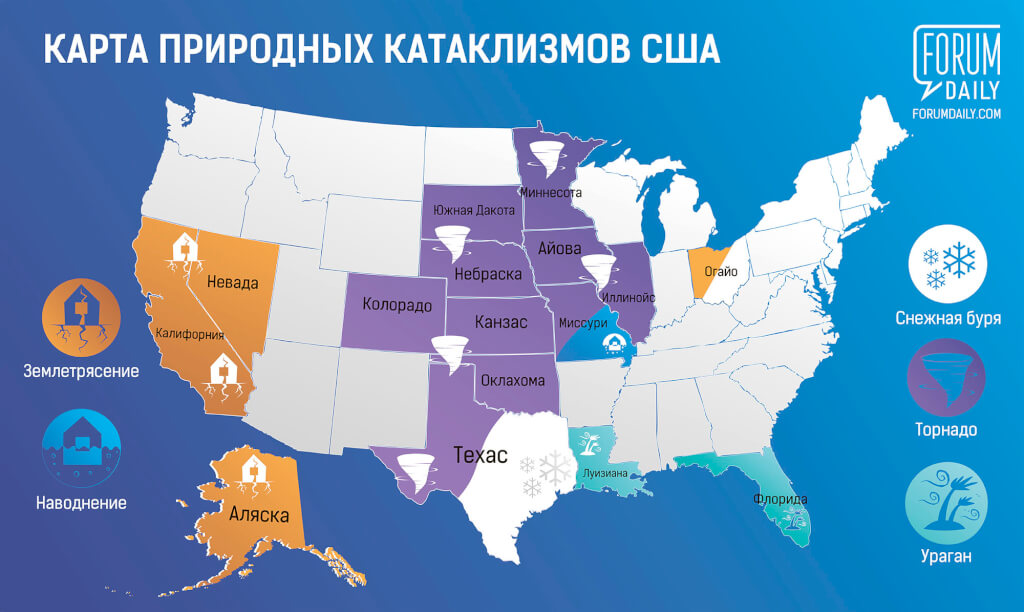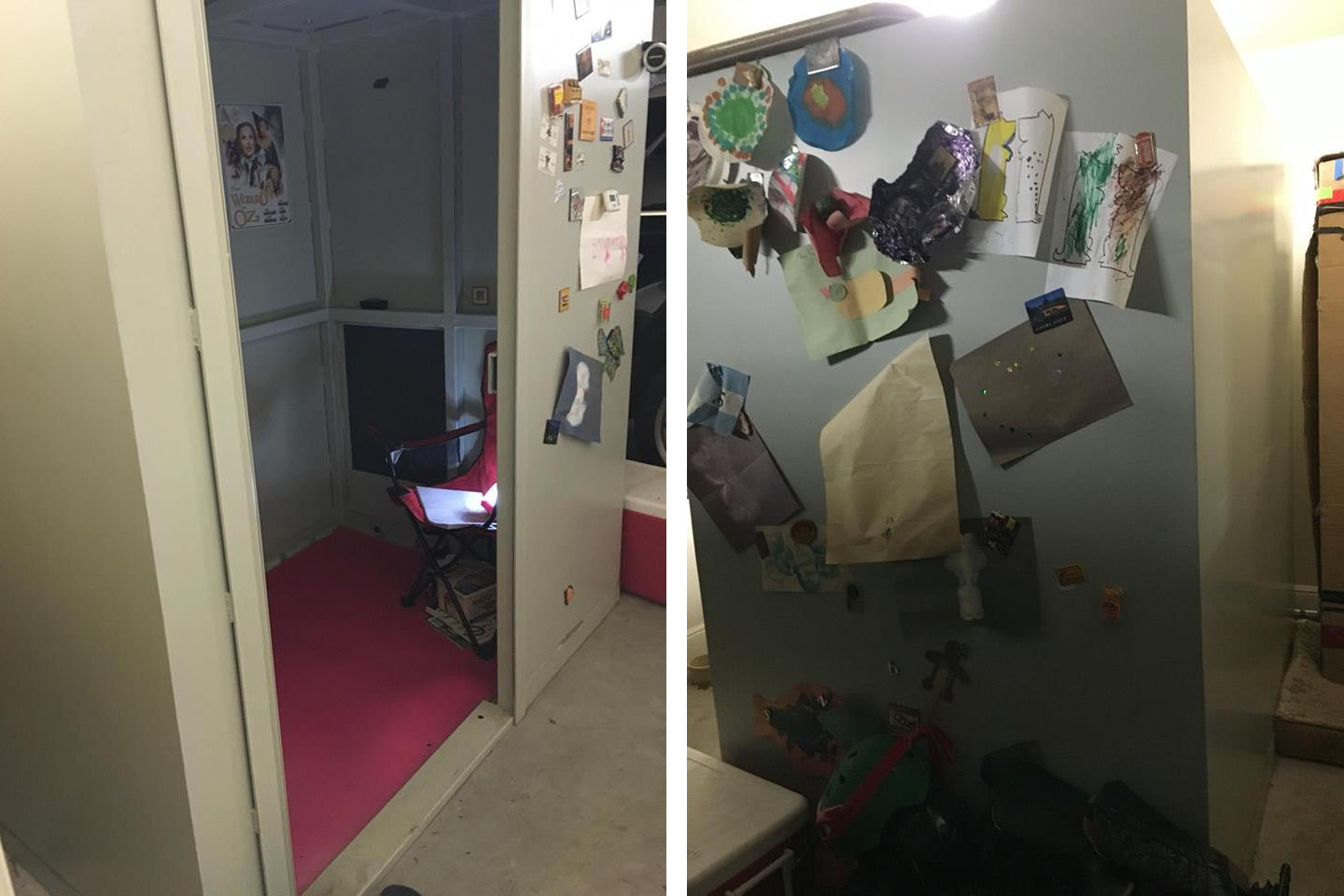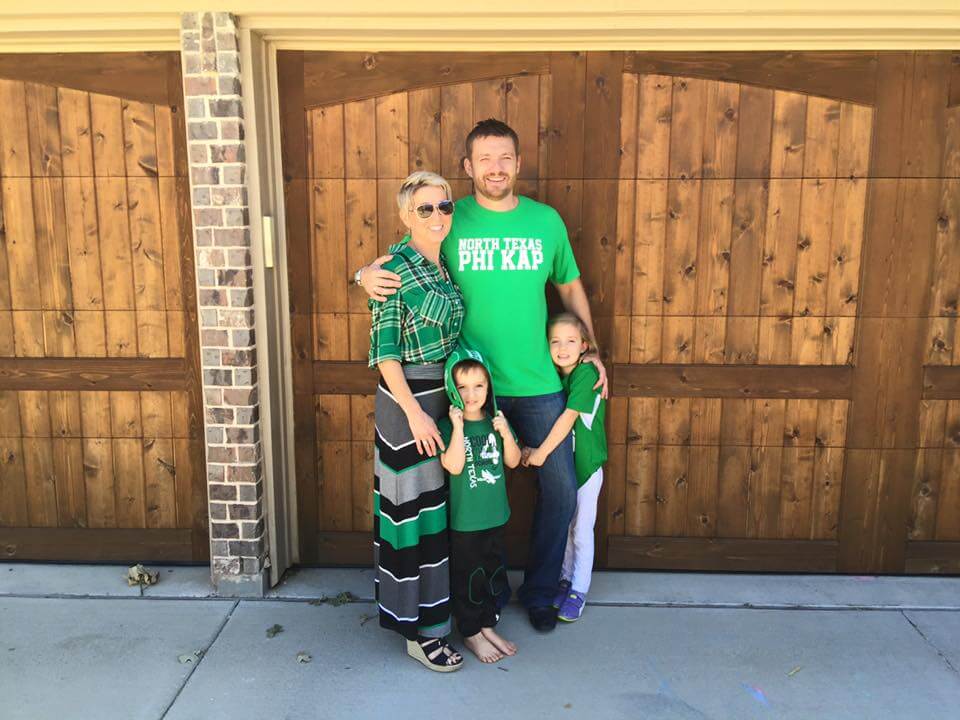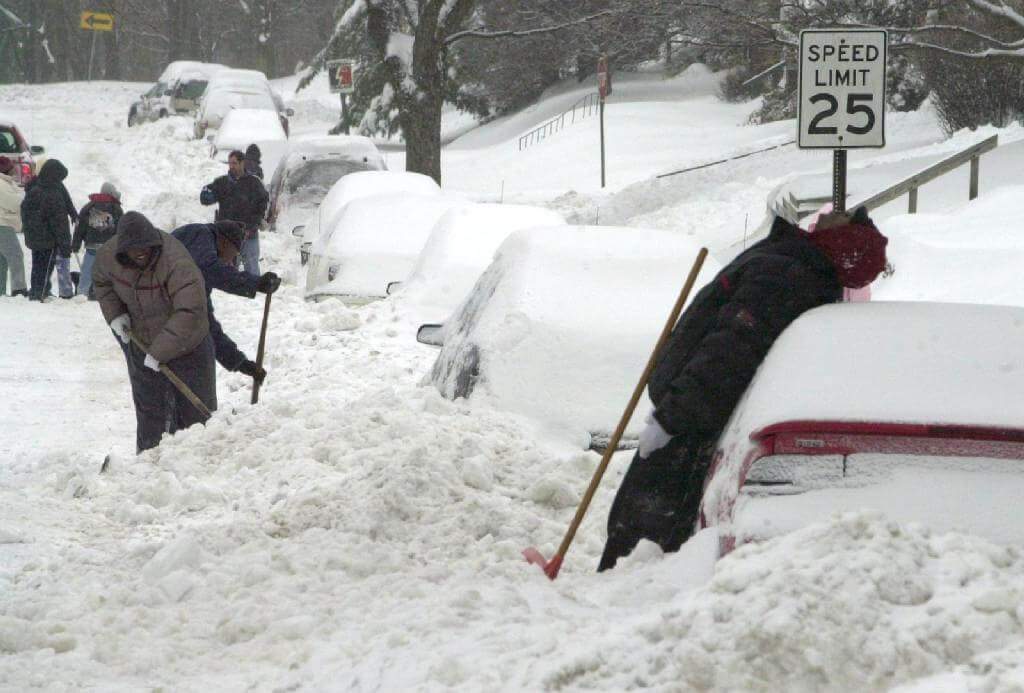Hurricanes, tornadoes and earthquakes in the USA: how to stay alive
Tornadoes, tsunamis, volcanic eruptions, earthquakes, forest fires, floods, drought. On 10, millions of square meters of US territory, which covers 11 climatic areas, everything happens. ForumDaily studied in which states you can face a natural cataclysm, what to do if you were in a disaster zone, and also talked to people from the CIS who experienced the violent temper of American nature.

In which states can a natural cataclysm await you? Illustration ForumDaily
Louisiana and Florida: the birthplace of hurricanes
Hurricane season lasts from early June to late November. The period from mid-August to early October is considered the most dangerous. Along the coast of the Atlantic Ocean, the Gulf of Mexico and Hawaii, the most devastating hurricanes sweep.
The unluckiest state in this regard is Louisiana. Over the past 10 years, it has experienced more than 20 shocks, including 2 tropical storms and 7 destructive hurricanes. During this time, insurance companies paid out more than $32 billion to residents who lost their homes. Hurricane Katrina, which struck Louisiana in 2005, caused the worst damage in US history.
More powerful but less devastating was Hurricane Andrew. In August 1992, he hit south Florida and southwest Louisiana. And in the spring of this year, Louisiana flooded. Under the water were dozens of settlements, thousands of residents had to be evacuated.
In late summer, another state suffered from hurricanes and tropical storms. This is Florida. Over the past 10 years, more than 10 hurricanes of varying degrees of destruction and 3 tropical storms have been recorded here. Insurance companies had to part with $ 30 billions.
In addition, the central part of Florida is called the American capital of lightning. It is here that the brightest and most dangerous flashes are recorded that lead to fires.
Texas: Snowstorms and Tornadoes
At least 1200 tornadoes are recorded in the United States every year. The favorite time of this natural phenomenon is spring. And one of the favorite states is Texas, followed by Kansas and Oklahoma.
Over the past 10 years, Texas has experienced 50 tornadoes, snow storms and hurricanes. Insurers paid out more than $25 billion. Local residents have to put up with heavy rains, tornadoes and hurricanes. The windiest cities are Galveston and Houston. Last year, Texas was hit by 9 tornadoes, killing more than a dozen people.
The entire central part of the United States - Texas, Kansas, Oklahoma, Colorado, Nebraska, Iowa, South Dakota, Minnesota and Illinois - is even called "Tornado Alley." Over the course of decades, about 90% of tornadoes form here. The Alley collected the saddest statistics in 1965, when more than 30 tornadoes with a crater height of about 10 km were recorded here. In the states of this "Alley" that year, more than 300 people were killed or missing, and more than 2000 people were injured.
These states have special requirements for building design. Stepan Perfilyev knows what it’s like to live in anticipation of a tornado. In 1996, he exchanged Moscow for the state of Texas, and the wind, which blows at a speed of 200 km/h, became the norm for him.
“Tornadoes have become part of our lives and have already become commonplace. You hear a siren, grab the children and run to the shelter,” says Stepan.
A shelter is a large bunker, which, as they say, does not burn in fire, does not sink in water and is not afraid of tornadoes. “This is a large box that is bolted to the floor and can withstand maximum wind pressure,” explains Stepan. “I put it in the garage 3 years ago, and this shelter has already saved our lives: 5-6 times my wife and children took refuge here from tornadoes.”

Stepan's family is hiding in the bunker during training alarms, and the children have already turned it into a small playroom. Photo by Stepan Perfilyev
The children of Stepan, by the way, treat these gifts of nature calmly. They are accustomed from birth, like all residents of Addison and other cities in Texas, where tornadoes drop in.
“The city holds drills once a month, so children know what to do and where to run. They've even equipped the shelter with everything they personally need—toys, pencils—so they even have a supply of entertainment in case of a tornado. In addition to toys, food and water are stored there, of course, that is, all the necessary emergency supplies,” says Stepan.

The family of Stepan Perfilyev is already accustomed to the fact that tornadoes have become constant companions of their lives. Photo by Stepan Perfilyev
Those who do not have special shelters, during a training or real alarm, take refuge in rooms without windows - such, according to the rules of development, should be in every house.
Oklahoma and Illinois: In the Heart of Tornado Alley
The best rescuers in the United States would come from the inhabitants of this state. Over the past 10, Oklahoma’s population has had to endure 39 tornadoes of varying degrees of severity. Therefore, it is not surprising that people cope with natural disasters as professional lifeguards.
The state of Illinois, which is also located on Tornado Alley, is lucky not only with tornadoes and hurricanes. In winter, powerful snow tornadoes and storms arrive from the Great Lakes region, which completely paralyze the lives of the local population.
Alabama and Tennessee: storms and storms
Blizzards, tropical storms, tornadoes and hurricanes are what residents in Alabama and Tennessee have to endure. In the first state, the cities of Tuscaloosa and Birmingham suffer the most from the disaster. Well, the entire state, without exception, gets a portion of the tropical showers that the Gulf of Mexico generously supplies them with. In Tennessee, residents have already come to terms with the fact that their state is hit by the most powerful series of tornadoes.
HOW TO CONDUCT YOURSELF DURING HURRICAN, STORM, MORNING
Indoors, if there is no special shelter:
Close all windows and do not approach them.
Turn off all electrical appliances.
The safest place is the doorway.
Outdoors
Do not approach bridges, trees, billboards, poles, cars.
The best place to hide is an underground passage. Or find a hole in the ground, lie down and cover your head with your hands.
Move away from flammable objects - gas stations, power lines.
In car
Park near the wall in the wind or in a ditch.
Ohio: sweeps snow and shakes
It is difficult to say what time of year is calm in this state. In winter there are snowstorms, in spring the center and south of the state suffer from tornadoes, and in summer and autumn earthquakes occur. Over the past 10 years, there have been more than 3 dozen shake-ups.
Natalya Oruil left Ohio after the divorce precisely because she could not cope with winter everyday difficulties. “There is so much snow that sometimes you just can’t leave the house. You can’t cope without male strength,” she says.

In winter, snowstorms paralyze Ohio. Weather.gov photo
The first serious snowfall after her divorce from her husband became a real catastrophe for her: “I was trapped at home, I could not dig out the car, it was very difficult to cope with life. It was necessary for 2-3 of the day to sit in the house before the rescuers helped to get out into the street. Houses always needed to have a supply of food, batteries, flashlights. ”
Natalya, without hesitation, decided to move. “After surviving one winter, I realized that I couldn’t live in this state. I found a job at a bank, interviewed via Skype, and moved to Arizona. The biggest problem right now is the heat. But after snow storms, for me it’s not torture, but relaxation,” she admits.
Missouri: great floods and tornadoes
If we study the history of the most powerful floods in the United States, several states will appear in all of them (because if they are drowning, then they will be big) and Missouri will definitely be among them. The most devastating "Great Mississippi Flood" occurred here in 1927 year. 85 people died, more than 1000 were injured. Almost 18 hours were continuous downpours, the river overflowed and broke through the dam. In some places, the water rose to 10 meters, and the Mississippi River itself spilled into 97 kilometers. Besides Missouri, Kentucky, Arkansas, Illinois, Louisiana, Mississippi, Tennessee, Texas, Oklahoma and Kansas were flooded.
This year in Missouri, there was also a strong flood that killed more than 20 people.
Missouri was also notorious as a state in which a tornado-killer rushed in, killing people from 1986 to 250 in the 500 year. The exact number of victims could not be named, because many bodies were carried into the river.
But this nature was not enough. In the 1992 year, heavy rains poured in Missouri throughout the fall, a lot of snow fell in winter, and in the spring of 1993, it flooded in such a way that the flood of 1927 in its power seemed not such a big disaster. Flooding lasted six months: from April to October. Tens of thousands of houses were destroyed, fifty people died and went missing. Material damage amounted to more than $ 15 billion, not including insurance company payments.
California, Alaska and Nevada: Ring of Earthquakes
There are several seismically active zones in the USA. About 90% earthquakes occur in California, western Nevada and Alaska. The most devastating earthquakes occurred in San Francisco in the 1906 year and in Alaska in the 1964 year.
In San Francisco, a natural disaster claimed the lives of about 3000 people and destroyed 80% of buildings. The 9,2 magnitude earthquake in Alaska was the most powerful in US history. More than 100 people died then, most due to the tsunami with 20-meter waves that hit the state after the earthquake.
HOW TO CONDUCT YOURSELF DURING THE TSUNAMS
The first sign of a tsunami is a change (rise or fall) of sea level along the coastline.
When approaching a tsunami, go to an elevation, as far as possible from the coast.
If there is no hill, move away at least 3 km from the coast.
Do not approach and do not approach the sea to look at how the tsunami goes to the coast: when the wave is in sight, you will not have time to hide and escape.
Never go down to the sea to look at the bottom exposed during a tsunami or to look at a tsunami. When you see the approaching wave, it will be too late to save.
Remember that a tsunami is a series of waves, the interval between which can be several hours. Only special services can clear the alarm.
The cause of these earthquakes, like most tremors in the United States, is said to be the movement of the Pacific and North American plates, between which the famous San Andreas fault is located. Once every 120-140 years, earthquakes with a power of more than 8,5 occur here. Earthquakes with a power of about 8 occur more often - once every 10 years. Also included in the Pacific Rim zone is the state of Washington, where earthquakes up to magnitude 8 are recorded once every 20 years.
Scale earthquake intensity
1 score (imperceptible) - marked only by special devices;
2 points (very weak) - only felt by very sensitive pets and some people in the upper floors of buildings;
3 points (weak) - only felt inside certain buildings, like shaking from a truck;
4 points (moderate) - earthquake is noted by many people; possible oscillation of windows and doors;
5 points (quite strong) - swinging of hanging objects, creaking floors, glass rattling, shedding whitewash;
6 points (strong) - slight damage to buildings: thin cracks in the plaster, cracks in the furnaces, etc .;
7 points (very strong) - significant damage to buildings; cracks in the plaster and the breaking off of individual pieces, thin cracks in the walls, damage to chimneys; cracks in wet soils;
8 points (destructive) - destruction in buildings: large cracks in the walls, falling eaves, chimneys. Landslides and cracks up to several centimeters wide on mountain slopes;
9 points (devastating) - collapses in some buildings, the collapse of walls, partitions, roofs. Collapses, debris and landslides in the mountains. The rate of advancement of cracks can reach 2 cm / s;
10 points (destroying) - collapses in many buildings; in the rest - serious damage. Cracks in the ground up to 1 m wide, landslides, landslides. Due to the blockages of river valleys there are lakes;
11 points (disaster) - numerous cracks on the surface of the Earth, large landslides in the mountains. General destruction of buildings;
12 points (severe disaster) - relief changes in large sizes. Huge landslides and landslides. The total destruction of buildings and structures.
In Alaska, an 7,1 magnitude earthquake was recorded this year, and in San Francisco, the last powerful earthquake with a magnitude 6,1 occurred in August of the 2014 year. Then more than 100 people were injured. Nearly a hundred people were also injured in nearby Napa, and water and gas supplies were interrupted.
Mikhail Buznik well remembers the events of 2014 of the year, because it was his first week in San Francisco. He and his family won the green card. Everything was sold in his native Novgorod, an old point was put on his old life. The family moved to San Francisco, where Michael lived relatives. And the very first week in a new place brought an unpleasant surprise.
Mikhail recalls that his first reaction was a feeling of helplessness: “When the walls are shaking and you don’t understand what will happen to you and your children, when you wake them up in the middle of the night and don’t know where to run, it’s very scary. The house began to shake, vases fell, and a television collapsed from the wall. I grabbed the children, my wife took the documents, and we ran out into the street. I remember how my hands were shaking, and I didn’t even think about how to hide my panic. Fortunately, that night, with one push, it all ended and did not happen again. We have no plans to leave California. There is no place on earth that is 100% safe. Fear for your life will be everywhere you go.”
That same year, California nearly lost the championship to another state. In Oklahoma in July 2014, 7 earthquakes occurred at once. The magnitude of the shocks ranged from 2,6 to 4,5. Seismologists have already drawn the attention of the authorities to the fact that in recent years the number of earthquakes has increased several times in oil and gas producing states - Oklahoma, Texas, Colorado, Arkansas, New Mexico. For example, in the same Oklahoma, from 1980 to 2010, 2 earthquakes more powerful than 3 points were recorded per year, and last year more than 200 strong tremors were counted.
HOW TO CONDUCT YOURSELF DURING THE EARTHQUAKE
If you are indoors, hide under a table or stand in a corner of the room.
Get away from windows and heavy objects.
If you are standing on the street near the tall buildings - stand in the doorway.
Do not run out into the street if an earthquake caught you in the house, so as not to fall under the rubble of crumbling structures.
Do not use the elevator and the stairs: the elevators will stop, as the emergency sensor will work, a traffic jam may form on the stairs.
If you are in a car, drive away from bridges and high-voltage lines and stay in the car.
Do not leave the shelter after the first shock, it may be followed by new (so-called aftershock) earthquakes, which follows the first shock.
Authorities warn and help
In order for US residents to be prepared for emergencies and to know how to behave, the government created portalwhere you can find information on how to prepare for an emergency in order to protect your home and family.
Regardless of which state you live in, it is recommended to have a set of emergency facilities in your home: a flashlight, a portable radio, spare batteries, blankets, a first aid kit, a 3-day supply of canned food and a supply of water for 3 days. This stock is asked to be stored compactly and in one place so that in the case of a state of emergency a kit can be easily found.
For those affected by the disaster, an Emergency Relief and Resource Center has been created. To contact the Center you can go to broker or call: 1-800-621-3362. Room for the hearing impaired: 1-800-462-7585.
Interactive maps have been created to control the elements and natural disasters. You can receive real-time information about tornado, earthquakes and about the weather in all US states.
Read also on ForumDaily:
10 things worth having in the house so as not to be afraid of the hurricane and the flood
Russian scientist at the time of Irma provided his home in Miami with electricity and television
Like a coin frozen in a cup of water can help during a hurricane
State Department provides free travel service for US citizens
Subscribe to ForumDaily on Google NewsDo you want more important and interesting news about life in the USA and immigration to America? — support us donate! Also subscribe to our page Facebook. Select the “Priority in display” option and read us first. Also, don't forget to subscribe to our РєР ° РЅР ° Р »РІ Telegram and Instagram- there is a lot of interesting things there. And join thousands of readers ForumDaily New York — there you will find a lot of interesting and positive information about life in the metropolis.











